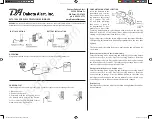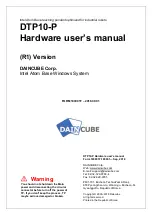
21
One informal method to determine a sample Precipitation Rate is to
place catchments at intervals over the area irrigated by a single zone.
There are officially calibrated catchment kits, or straight-sided metal
cans of equal height can be used.
The catchments should be placed at different distances from the
sprinkler heads. The more catchments, the better the test.
Run the zone for an exact period of time, divisible into 1 hour. 5 min-
utes is a good quick test for spray heads; 15 minutes might be better
for rotor zones.
Measure the amount of water in each catchment as accurately as pos-
sible. A metal ruler or machinist’s scale is good for this purpose.
Add the measurements of all the containers, and divide the total by
the number of containers, to get the average precipitation for the
test period. Irrigation consultants will generally establish a factor for
distribution uniformity (DU) that indicates the overall efficiency of a
zone. For ET System purposes, the precipitation rate entered should
be the adjusted rate, and the averaging process described here will
usually be adequate.
Multiply the results by the number of times the test period will divide
into 1 hour (12 x 5 minutes for the sprays, 4 x 15 minutes for the
rotors, in the example), to get the Precipitation Rate in inches or mil-
limeters per hour.
This is the amount to enter for “CUSTOM” in the Sprinkler Type
dial position.
Enter a Custom Precipitation Rate:
Use the +/- keys to cycle through
the choices until CUSTOM is displayed.
Use the arrow keys to advance to the PRECIP position. The Precipita-
tion will be set to 1.6"
Use the +/- keys to change the Precipitation Rate to the desired
number.
Continue to enter Sprinkler Type data for each station, by pressing the
STA button and repeating the sprinkler selections, until finished.
When all stations have Sprinkler Type data, turn the dial to save the
information. For initial setup, proceed to the Water Days dial position.
Water Days
The Water Days dial position sets the days of the week on which it is
permissible to water. This does not necessarily mean watering will oc-
cur on Days OK to Water, only that it is permitted if conditions require
watering.
Water Days apply equally to all stations, and only need to be set up in
a single screen (not one per station).
DAYS OK TO WATER
SU MO TU WE TH FR SA
Y Y Y Y Y Y Y
EVEN ODD INTERVAL
- - -
All days will initially be set to Y (Yes). The first day (Sunday) will be
highlighted. To change the Y to N (No), use the +/- keys. Set any days
on which you are not allowed to water, or don’t wish to water, to N.
When the Y/N setting is changed, ET System will automatically jump
to the next day. Use the left key to go back, if the day Y/N setting
needs to be changed again.
Use the right arrow to skip past days that do not require changing.
Use +/- to set each day to Yes or No; when the week is set up cor-
rectly, turn the dial to the next position.
Interval Days:
ET System can be programmed to water on intervals, instead of
specific days of the week. Use the arrow keys to move to the Interval
position, and press the + button. The dash will change to a Y under
Interval, and the interval settings will replace the Day of Week display.
You may set from 1 to 31 day intervals. Use the arrow keys to move to
the Interval field, and press +/- to set the Interval.
Summary of Contents for ET System
Page 4: ...D 2 A B C E ...














































